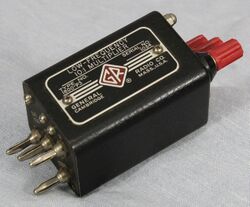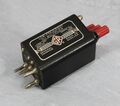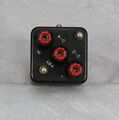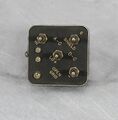1800-P3: Difference between revisions
Jump to navigation
Jump to search
No edit summary |
No edit summary |
||
| (One intermediate revision by the same user not shown) | |||
| Line 1: | Line 1: | ||
{{GR Product | {{GR Product | ||
|model=1800-P3 | |model=1800-P3 | ||
|codes=ABEAM | |||
|class=meters | |class=meters | ||
|summary=Low-Frequency Multiplier | |summary=Low-Frequency Multiplier | ||
| Line 15: | Line 16: | ||
The {{Title|General Radio 1800-P3 Low-Frequency Multiplier}} was introduced in {{Catalog M}} and remained available through {{Catalog Q}}. | The {{Title|General Radio 1800-P3 Low-Frequency Multiplier}} was introduced in {{Catalog M}} and remained available through {{Catalog Q}}. | ||
The Type 1800-P3 is an accessory for the [[1800-A|Type 1800-A Voltmeter]] designed to increase the input voltage range to | The Type 1800-P3 is an accessory for the [[1800-A|Type 1800-A Voltmeter]], a compensated 10:1 voltage divider designed to increase the input voltage range to 1500 V. | ||
The multiplier is not recommended for use above 100 kHz unless adjusted for use at a fixed frequency. | The multiplier is not recommended for use above 100 kHz unless adjusted for use at a fixed frequency. | ||
Above 100 kHz, the [[1800-P2|Type 1800-P2 Multiplier]] is recommended. | Above 100 kHz, the [[1800-P2|Type 1800-P2 Multiplier]] is recommended. | ||
Latest revision as of 19:29, 30 May 2024
The General Radio 1800-P3 Low-Frequency Multiplier was introduced in Catalog M (1951) and remained available through Catalog Q (1961).
The Type 1800-P3 is an accessory for the Type 1800-A Voltmeter, a compensated 10:1 voltage divider designed to increase the input voltage range to 1500 V. The multiplier is not recommended for use above 100 kHz unless adjusted for use at a fixed frequency. Above 100 kHz, the Type 1800-P2 Multiplier is recommended.
The multiplier attaches to the 1800-A probe observing the connections displayed at the output of the multiplier.
Specifications
- Multiplier Ratio DC: 10:1 ±1%
- Multiplier Ratio AC: 10:1 ±0.5%
- Input Impedance: DC 10 MΩ; AC 10 MΩ // 10 pF






